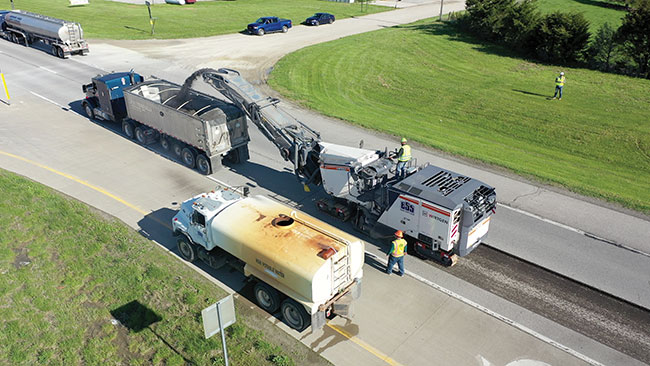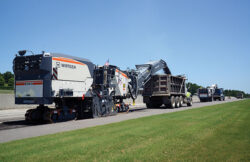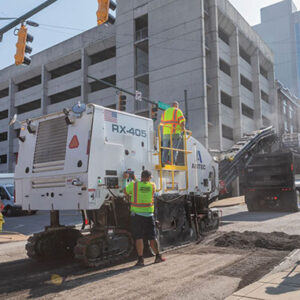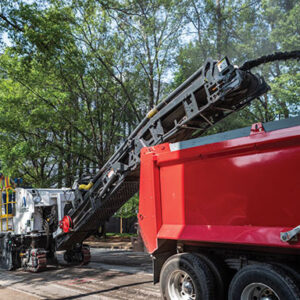
Features
It’s milling time!
What you need to know about the latest milling equipment
November 27, 2023 By Andrew Snook

When it comes to milling equipment, the needs and demands each contractor has can vary from job to job. However, there are some common needs that original equipment manufacturers (OEMs) have identified for many of their customers. One of the biggest drivers for investment for certain milling technologies is the level of experience of a company’s crew. Less experienced crews value a simpler machine says Raleigh Harrelson, product verification and validation supervisor for Astec.
“Often times, with smaller contractors, the main necessity is ease-of-use. They most likely don’t have a fleet of employees who are familiar with milling machines,” explains Harrelson. “They need a machine with a low learning curve to get things moving quicker.”
Tom Chastain, milling product manager for Wirtrgen America, says having milling equipment in the fleet that is operator friendly will help companies speed up their hiring processes, alleviating some labour stresses brought on by an increasingly difficult time for finding and hiring experienced milling machine operators.
“Having milling machines that are operator friendly is critical. By creating Mill Assist, Wirtgen has developed a solution that allows the operator the option of preselecting settings to let the machine automatically adjust the speed of the engine and milling drum, the traction drive, the water system and the machine’s ground speed,” Chastain says. “It allows the operator to be more productive with less experience, providing high quality and production, while lowering the machines CO2 footprint.”
While ease of use features are popular with most contractors, those that have a large pool of experienced operators to draw from will often have different priorities when assessing new milling equipment to purchase, including transitions over obstacles and other things that might be in the way.
“Larger contactors who have more resources at their disposal are more focused on a machine’s production,” Harrelson says. “Horsepower is part of that production need, but not all of it. The ability to quickly transition over structures; transition in and out of the cut, is critical. Once the machine steps in and starts moving, the horsepower component of production is fairly easy to achieve, but a contractor who has learned to transition quickly and accurately is ahead of the game. When you start a cut, the machine had to do it correctly to maintain the grade and it there are manholes or any other obstructions that can’t be milled, you have to pick up, move over and then step back in. Getting through those transitions quickly is what makes these contractors stand out.”
Latest features
One of the newer technologies that contractors have gained a lot of value from is the evolution of grade controls.
“Precision grade control is a must for milling contractors. Leveling systems especially developed for cold milling machines use operating panels that are intuitive and easy to operate. They are fully integrated into the machine control system and enable a high degree of automation. This allows operators to avoid obstacles, like manholes, and get right back into the cut.” Chastain says.
He adds that 3D has become increasingly relevant in the milling space.
“3D, when correctly set up with the machine, can further automate the job requirements like cutting depth, and road profile. It’s important to have a system that can easily interface with a variety of manufacturers’ 3D systems,” Chastain says. “Wirtgen LEVEL PRO ACTIVE offers a simple and field-tested 3D system interface with the 3D kit.”
Contractors are extremely interested in automation within milling machines, looking for any equipment features that can efficiently replace manual processes.
“Accurate automation can be a timesaver in the milling process. Anything from automated controls to slope and grade automation that can help crews mill more efficiently and effectively is a win. OEMs are always innovating to help with ease-of-use,” Harrelson says.
Maintenance tips
To ensure long life for milling equipment, using a proper maintenance schedule for the equipment is key.

Road work being performed with the use of Wirtgen milling equipment. Photo provided by Wirtgen.
“Drum maintenance is critical to maintain a healthy milling machine. As the teeth rotate, it wears on the holder faces and, after a season or so, there is additional maintenance that must be performed, depending on how many hours were put on the machine. You may also need to go through and rebuild holders in the machine. Maintaining a healthy mill goes beyond daily upkeep, we need to think long term and prioritize maintenance,” said Chastain.
In addition to maintaining the usual suspects – drums, holders, teeth, bearings, oil filters, DEF systems – Chastain says maintaining and cleaning the conveyor belts is also vital.
“A lot of the time we just look at the outside of the conveyor belt for damage, when in reality, for doing proper maintenance, you need to check for buildup of material on the heads and tail pulleys,” he says.
“The abrasiveness of the material that gets packed on those pulleys can delaminate the belt from the inside. Wirtgen has robust, yet easy to clean conveyor systems, with buildup protection in mind.”
Chastain adds that the addition of new technologies and features has meant that maintenance has become easier on most milling machines, which is a big help to the crew at the end of the day.
“Making the maintenance on these machines easier is a big factor because after you put in 12 to 14 hours in the beating sun all day, the last thing you want to do is change teeth, grease the machine, etc. To making things easier on the crew, maintenance points have been centralized, like slide out filters for ease of change,” he says.
One of the most important things to remember when it comes to maintaining milling machine equipment is that any unplanned downtime can bring an entire operation grinding to a halt.
“If it’s a mill-and-fill situation and the milling machine goes down, it’s not just the milling machine. It’s the pavers, the rollers, and the asphalt plant,” Chastain says.
Preparing for a breakdown in advance, including having back-up componants already on site, can help alleviate some of the downtime, making repairs easy and preventing a wait for back-ordered componants.
“Back-up components help prevent downtime on projects and using the machine display, the operator can see what the issue is, and how to resolve it,” said Chastain.
Print this page

